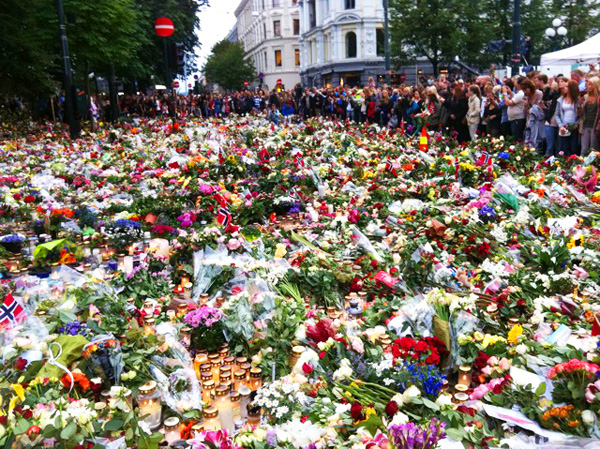But it did. Norway is still in shock after the events of Friday 22 July 2011 – a date that will forever be remembered as a turning point in Norwegian history.
At 3:30 in the afternoon, Norway, with its nearly 5 million inhabitants, experienced its first terrorist attack. A car bomb exploded in the street outside the main government buildings in the centre of Oslo. The bomb was so big and the blast so powerful that it could be heard far outside the city. It destroyed nearby buildings and smashed hundreds of windows throughout the capital.
News about the explosion contained further information about a possible shooting on Utøya. There was some confusion to begin with as to whether the two episodes were related and at first the shooting was thought to be fireworks.
As the day wore on, a shocked Norwegian public tried to make sense of what was happening. There had indeed been shooting on Utøya and many had been killed. Utøya (literally “the outside island”) is about two hours drive from Oslo and is well known as the venue for the Labour Party’s yearly summer youth camp.
Three hours after the explosion, Oslo was empty of all but police cars, ambulances, commando trucks and fire engines. With typical Norwegian efficiency a central command was immediately established on the largest town square. The sound of sirens continued throughout the evening and night, and the media confirmed that a man had been arrested on Utøya and charged for both crimes.
A native Norwegian man in his thirties admitted responsibility for the home-made bomb and for the massacre on Utøya. A right-wing extremist with strong anti-Islamic views, he blames the Norwegian Labour Party for allowing the immigration of Muslims to Norway and turning Norway into the multicultural society it is today. The attacks were aimed at destroying the Labour Party and killing its new recruits on Utøya.
Numbers of dead and injured were expected to increase during the night as rescue teams continued to search the government buildings and the island. Thankfully these were adjusted down the next day, but they were horrific. 8 people had been killed in the government buildings and 69, the youngest 14 years old, had been shot and killed on Utøya.
Oslo was a silent, mourning city on Saturday. Television stations sent continuous updates showing pictures taken immediately after the bomb exploded. Nearly all the shops were shut and the task of assessing the damage had begun. The normally busy city centre was empty and most of central Oslo had been fenced off as there was speculation about further undetonated bombs.
Ever the pragmatists, the Norwegians discussed positive aspects. For example, the government “high-rise building” or “Høyblokken” built in 1958 could, after all, be salvaged. The bomb had done extensive damage but the foundations were sound. Also, the majority of those who would normally be working in these buildings were on holiday – July is the main holiday month. In addition, the car containing the bomb had been parked over the extensive underground passages which connect the government buildings and this helped to absorb some of the blast.
By Monday morning carpenters and renovation teams had replaced broken windows with weatherboards and removed all the broken glass from the streets. They had been working all weekend – an amazing feat.
The first flowers and candles were already being placed outside the Cathedral in Oslo and as the days went by they filled more and more of the area around the church. Groups stood silently looking at the sea of flowers, many crying openly. This happened in towns all around the country. Very different Norwegians from the rather private people they are known to be. This somewhat Catholic tradition for showing public sorrow started when King Olav V died in January 1991 when the snow outside the Royal Palace was covered by candles and flowers.

Strangely, Norwegian flags were missing from the floral tributes. Norwegians are proud of their flag and exhibit a friendly and good-natured nationalism. The sorrow shown after the massacre was personal and the sense of bereavement transcended nationality.
This could be seen in the rose procession. 200,000 people each carrying a rose filled the streets of Oslo to express their support for a society that condemned terrorism, whoever was responsible. Norway has always defended her open society. Locked doors with codes and entrance cards are relatively new here. However, Norwegians are sceptical in spite of promises from the Prime Minister that there will be more openness in the future.
There has been much soul-searching in the aftermath of the terror. As would be expected of a society concerned with details and punctuality, the rescue operation on Utøya has been studied minute for minute. Could the police have been more efficient? Could more lives have been saved? What if, what if?
An immigrant was stopped in the street by reporters and asked for his comments. His reply was “My first thought when I heard about the bomb was ‘I hope it is not one of ours’ ”.
This is a sentiment that has been expressed by many Norwegians. They are thankful that the perpetrator was a so-called native. Norway struggles to integrate its immigrants like so many other nations and had one of them been responsible, this wonderful country would have looked very different today.
Flowers are still being laid outside the Cathedral and there are always roses on the fences around the government buildings. The heavy silence over Oslo has now lifted and voices and laughter can be heard again in the streets but it is going to take a very long time to get back to normal – whatever “normal” will mean in the future.
Post Tags: Tags: 22 July 2011, Norway, Norwegian history, Oslo, Utøya
